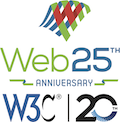News
HTML5 is a W3C Recommendation
28 October 2014 | Archive
 The HTML Working Group today published HTML5 as W3C Recommendation. This specification defines the fifth major revision of the Hypertext Markup Language (HTML), the format used to build Web pages and applications, and the cornerstone of the Open Web Platform.
The HTML Working Group today published HTML5 as W3C Recommendation. This specification defines the fifth major revision of the Hypertext Markup Language (HTML), the format used to build Web pages and applications, and the cornerstone of the Open Web Platform.
“Today we think nothing of watching video and audio natively in the browser, and nothing of running a browser on a phone,” said Tim Berners-Lee, W3C Director. “We expect to be able to share photos, shop, read the news, and look up information anywhere, on any device. Though they remain invisible to most users, HTML5 and the Open Web Platform are driving these growing user expectations.”
HTML5 brings to the Web video and audio tracks without needing plugins; programmatic access to a resolution-dependent bitmap canvas, which is useful for rendering graphs, game graphics, or other visual images on the fly; native support for scalable vector graphics (SVG) and math (MathML); annotations important for East Asian typography (Ruby); features to enable accessibility of rich applications; and much more.
The HTML5 test suite, which includes over 100,000 tests and continues to grow, is strengthening browser interoperability. Learn more about the Test the Web Forward community effort.
With today’s publication of the Recommendation, software implementers benefit from Royalty-Free licensing commitments from over sixty companies under W3C’s Patent Policy. Enabling implementers to use Web technology without payment of royalties is critical to making the Web a platform for innovation.
Read the Press Release, testimonials from W3C Members, and acknowledgments. For news on what’s next after HTML5, see W3C CEO Jeff Jaffe’s blog post: Application Foundations for the Open Web Platform. We also invite you to check out our video Web standards for the future.
W3C releases Code of Ethics and Professional Conduct
23 October 2014 | Archive
W3C released today a Positive Work Environment Framework that includes a Code of Ethics and Professional Conduct and accompanying procedures. Both guidelines are now in effect and govern our work environment.
W3C is a growing and global community where participants from all horizons choose to work together. Our Code of Ethics and Professional Conduct defines a set of community principles and promotes high standards of professional practice. It also acts as a vehicle for better identity of the organization which celebrates its 20th anniversary this month.
First Public Working Drafts: Activity Streams 2.0, and Activity Vocabulary
23 October 2014 | Archive
The Social Web Working Group has published two First Public Working Drafts today:
- Activity Streams 2.0. This specification details a model for representing potential and completed activities using the JSON format.
- Activity Vocabulary. This specification describes the Activity vocabulary.
Learn more about the Social Activity.
Canonical EXI Draft Published
23 October 2014 | Archive
The Efficient XML Interchange Working Group has published a Working Draft of Canonical EXI. Any EXI document is part of a set of EXI documents that are logically equivalent within an application context, but which vary in physical representation based on differences permitted by the Efficient XML Interchange (EXI) Format 1.0 (Second Edition). This specification describes a relatively simple method for generating a physical representation, the canonical form, of an EXI document that accounts for the permissible changes. An example of the applications targeted by this specification is one that needs to guarantee non-repudiation using XML Signature yet allows certain flexibility for intermediaries to reconstitute the documents before they reach final destination without breaking the signatures. Note that two documents may have differing canonical forms yet still be equivalent in a given context based on more elaborate application-specific equivalence rules which is out of scope of this specification. Learn more about the Extensible Markup Language (XML) Activity.
Resource Priorities Note Published
23 October 2014 | Archive
The Web Performance Working Group has published a Group Note of Resource Priorities. This specification defines a means for site developers to programmatically give the User Agent hints on the download priority of a resource, to allow User Agents to more efficiently manage the order in which resources are downloaded. This specification is no longer maintained and has been abandoned; refer to resource hints instead. Learn more about the Rich Web Client Activity.
Streams API, and The Screen Orientation API Drafts Published
23 October 2014 | Archive
The Web Applications Working Group has published two Working Drafts today:
- Streams API. WHATWG Streams API spec provides an API for representing and handling a stream of data in JavaScript. This W3C spec is intended to extend the WHATWG spec to meet requirements specific to the browser environment.
- The Screen Orientation API. The Screen Orientation API provides the ability to read the screen orientation type and angle, to be informed when the screen orientation type and angle, to be informed when the screen orientation state changes, and be able to lock the screen orientation to a specific state.
Learn more about the Rich Web Client Activity.
Updated Working Draft of HTML5: Techniques for providing useful text alternatives
23 October 2014 | Archive
An updated Working Draft of HTML5: Techniques for providing useful text alternatives was published today by the HTML Working Group. This publication incorporates changes and corrections reflecting work since October 2012, but does not include pending bugs listed in the status section. An updated publication including more specifics on description of complex images and clarification of other guidance is expected in the near future. Comments are welcome. Learn more about the HTML Activity and the Web Accessibility Initiative (WAI).
W3C Workshop Report: Web Cryptography Next Steps
23 October 2014 | Archive
W3C published today the report of the W3C Web Cryptography Next Steps: Authentication, Hardware Tokens and Beyond workshop held on 10-11 September, 2014, in Mountain View. Participants at the workshop expressed unanimous support for including standards-based access to hardware tokens in the charter of a future W3C Working Group or re-chartering of existing groups. Multi-factor and secure authentication are some of the driving use-cases. The discussion over chartering will take place on the Web Security public mailing list. W3C considers secure key storage and access to cryptographic operations important for the future of the Web. The fully booked Workshop was hosted by Microsoft, and sponsored by Google and Tyfone. Learn more about the Security Activity.
First Public Working Draft: Identifiers for WebRTC Statistics API
21 October 2014 | Archive
The Web Real-Time Communications Working Group has published a Working Draft of Identifiers for WebRTC’s Statistics API. Audio, video, or data packets transmitted over a peer-connection can be lost, and experience varying amounts of network delay. A web application implementing WebRTC expects to monitor the performance of the underlying network and media pipeline. This document defines the APIs and statistic identifiers used by the web application to extract metrics from the user agent. Learn more about the Ubiquitous Web Applications Activity.
First Public Working Draft: Resource Hints
21 October 2014 | Archive
The Web Performance Working Group has published a First Public Working Draft of Resource Hints. This specification defines ‘preconnect’ and ‘preload’ hints that the developer, or the server generating or delivering the resources, can use in an interoperable way to assist the user agent in the decision process of which origins it should connect to, and which resources it should fetch to improve page performance. Learn more about the Rich Web Client Activity.



